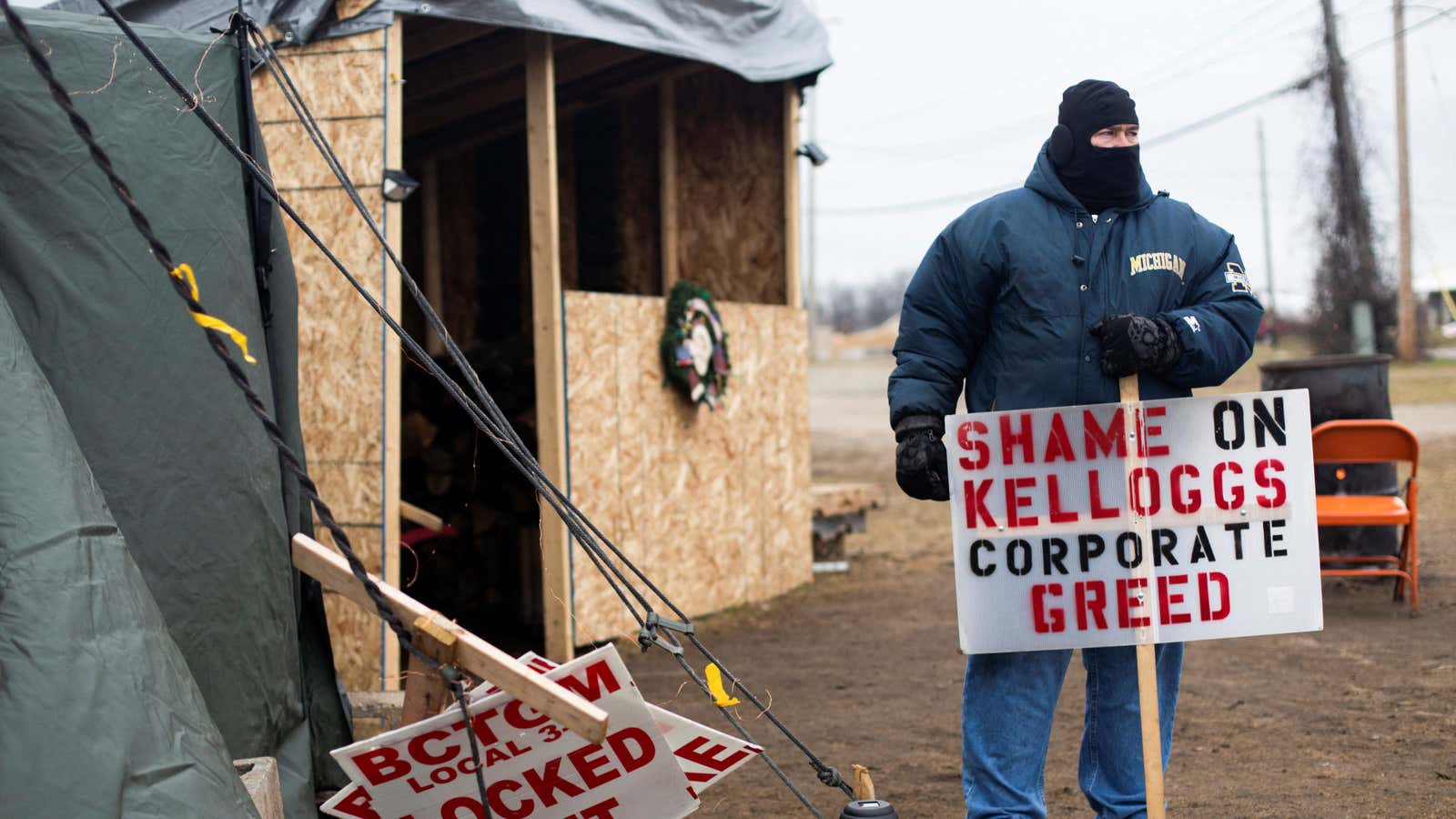In a tight US labor market, unionized workers have been demanding more. But labor is perhaps starting to lose the upper hand.
Following the failure to reach a contract with its union, Kellogg’s said it is permanently replacing striking workers. Some 1,400 hourly employees, who are part of the Bakery, Confectionary, Tobacco Workers and Grain Millers International Union, walked off the job across four cereal plants in Michigan, Nebraska, Pennsylvania, and Tennessee starting Oct. 5.
The rejected contract offer would have included a 3% wage hike for legacy employees and increases for newer hires. The company proposed eliminating the cap on the share of lower-tier workers, but some union employees were worried that would put downward pressure on veteran workers’ wages if lower-tier workers became a majority.
The food manufacturer has been on a hiring spree to replace the striking workers. The hourly rates for replacement workers posted on the Kellogg’s job board are $21.72 an hour for “general labor” and $34 to $37 for “skilled labor”, depending on the role. That’s comparable to the pay for the unionized legacy employees, who make on average $35.26 an hour, according to Kris Bahner, a company spokesperson.
The fact that the replacement wages are more or less the same as the previous pay suggests the labor market may not be as tight as union activists believe.
The unemployment rate in Battle Creek, Michigan is worse than the US average
In Battle Creek, Michigan, where Kellogg’s is headquartered, the labor situation has been challenging.
The unemployment rate in the city was 6% in October, which is higher than the national average of 4.6%, according to data from the US Bureau of Labor Statistics. The job opening rate, or the share of available jobs of all filled and unfilled positions, in the nondurable good industry—which includes Kellogg’s, one of the largest employers in the city—was 8%, higher than the national average of 6.9%. Meanwhile, the hourly earnings of all private-sector workers in Battle Creek was $26.22 in October, suggesting that Kellogg’s workers are highly compensated compared to the relative jobs in the area. That may boost the company’s confidence it will find workers to replace the ones striking, and undermine the union’s bargaining power.
“There’s a lot of potential labor supply for these jobs,” says Donald Grimes, a regional economic specialist at University of Michigan. “The idea that people are not going to take these replacement jobs is a bit inaccurate.”
Still, while the pay is high, it’s possible Kellogg’s is bluffing, Ruth Milkman, a professor at the City University of New York’s School of Labor and Urban Studies, wrote in an email. She said that while permanently replacing striking workers is both standard operating procedure and legal, recent strikes have not seen this outcome because it’s hard to find workers.
Labor resurgence?
From Nabisco to Amazon, the heightened labor activity in part stems from the pandemic, which has forced workers into more unsafe working conditions or less favorable schedules. Meanwhile, lower-wage workers, like those in the restaurant or retail industry, have been quitting at record rates, signaling that they feel confident they can find better jobs elsewhere—and can do so without a union.
But there are reasons to think that Kellogg’s union should have perhaps taken the deal.
The union may have had confidence its workers would not want to cross the picket line, but it’s not clear if that will be the case since the region’s unemployment rate is high and wages for Kellogg’s workers are better than the average job in the area. “I would just be a little bit careful if I was on the high end of the payscale if I was a union member,” says Grimes. “You could go overboard.”
And, despite most Americans supporting unions, union enrollment has been on a decline for decades. Just 10.8% of US employees are part of unions, according to the latest BLS data. Part of the reason for that is just how organizations have become more fragmented, according to Grimes. He adds, an increasingly larger share of jobs are in industries that have smaller firms, and it’s just harder to unionize smaller shops.
The bakery union still represents tens of thousands of workers at other companies, but the risk for striking workers is not just other workers filling their spots but also more investment in robots and automation to replace those workers, says Grimes. It’s possible that even if Kellogg’s union workers win this battle, they could still lose the war.
